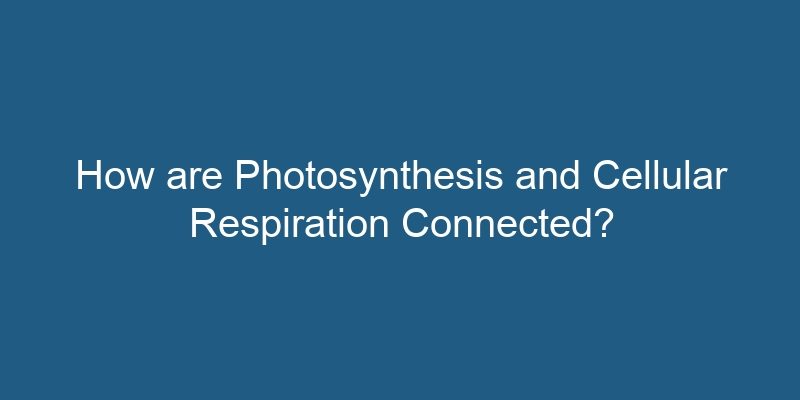Photosynthesis and cellular respiration are two essential processes that are interconnected in the world of living organisms. Both of these processes play vital roles in the energy flow and maintenance of life on Earth. In this article, we will explore the intricate relationship between photosynthesis and cellular respiration, diving deep into their mechanisms, similarities, and differences.
- The Process of Photosynthesis
- The Process of Cellular Respiration
- Relationship between Photosynthesis and Cellular Respiration
- Photosynthesis and Respiration
- The Interconnection between Photosynthesis and Cellular Respiration
- 1. Exchange of Gases
- 2. Energy Transfer
- 3. Recycling of Molecules
- 4. Complementary Timing
- Differences between Photosynthesis and Cellular Respiration
- 1. Location
- 2. Energy Conversion
- 3. Reactants and Products
- 4. Purpose
- Conclusion
The Process of Photosynthesis
Photosynthesis is a process by which green plants, algae, and some bacteria convert light energy into chemical energy in the form of glucose. It occurs in the chloroplasts of plant cells and involves several complex steps:
- Light Absorption: Chlorophyll pigments in the chloroplasts absorb light energy.
- Light-Dependent Reactions: Energy from light is used to split water molecules into oxygen, hydrogen ions, and electrons. This process occurs in the thylakoid membranes of the chloroplasts.
- Electron Transport Chain: The electrons released in the previous step are transported through a series of protein complexes, generating ATP (adenosine triphosphate) and NADPH (nicotinamide adenine dinucleotide phosphate) in the process.
- Calvin Cycle: The ATP and NADPH produced in the previous steps are used to convert carbon dioxide into glucose through a series of reactions. This process occurs in the stroma of the chloroplasts.
Overall, photosynthesis is an anabolic process that builds glucose molecules using light energy, water, and carbon dioxide. It is crucial for the production of oxygen and the storage of energy in organic compounds.
The Process of Cellular Respiration
Cellular respiration is a process that occurs in the mitochondria of cells to break down glucose and other organic molecules, releasing energy in the form of ATP. It can be divided into three main stages:
- Glycolysis: Glucose is broken down into pyruvate molecules, producing a small amount of ATP and NADH (nicotinamide adenine dinucleotide).
- Krebs Cycle (Citric Acid Cycle): Pyruvate is further broken down, generating ATP, NADH, FADH2 (flavin adenine dinucleotide), and carbon dioxide.
- Electron Transport Chain: NADH and FADH2 produced in the previous steps donate their electrons to the electron transport chain, which generates a large amount of ATP through oxidative phosphorylation.
Cellular respiration is a catabolic process that breaks down glucose and other organic molecules to release energy. It is essential for the survival and functioning of all aerobic organisms.
Relationship between Photosynthesis and Cellular Respiration
Photosynthesis and Respiration
The Interconnection between Photosynthesis and Cellular Respiration
Photosynthesis and cellular respiration are not isolated processes but are interconnected through the exchange of products and reactants. Let’s explore the relationship between these two processes:
1. Exchange of Gases
During photosynthesis, plants release oxygen as a byproduct. This oxygen is vital for cellular respiration in all organisms that require oxygen to produce energy. Simultaneously, plants consume carbon dioxide during photosynthesis, which is a waste product of cellular respiration.
2. Energy Transfer
The primary purpose of photosynthesis is to convert light energy into chemical energy stored in glucose molecules. This stored energy is later released during cellular respiration to generate ATP, the universal energy currency of cells. Thus, photosynthesis provides the energy source required for cellular respiration to occur.
3. Recycling of Molecules
Cellular respiration breaks down glucose molecules into carbon dioxide and water. These products are then used as reactants in photosynthesis to produce glucose again. In this way, the carbon and energy cycles are interconnected, allowing for the continuous recycling of molecules.
4. Complementary Timing
Photosynthesis primarily occurs during daylight hours when sunlight is available, while cellular respiration takes place continuously, both during the day and night. This complementary timing ensures that the energy needs of the organism are met throughout the day.
Differences between Photosynthesis and Cellular Respiration
While photosynthesis and cellular respiration are interconnected, they also have distinct differences:
1. Location
Photosynthesis occurs in the chloroplasts of plant cells and some bacteria, while cellular respiration takes place in the mitochondria of all eukaryotic cells.
2. Energy Conversion
Photosynthesis converts light energy into chemical energy, while cellular respiration converts chemical energy (glucose) into ATP.
3. Reactants and Products
Photosynthesis requires water, carbon dioxide, and light energy as reactants, producing glucose and oxygen as products. On the other hand, cellular respiration uses glucose and oxygen as reactants, producing carbon dioxide, water, and ATP as products.
4. Purpose
The primary purpose of photosynthesis is to produce glucose and oxygen, while cellular respiration aims to generate ATP for cellular processes.
Conclusion
Photosynthesis and cellular respiration are intricately connected processes that enable the flow of energy and maintenance of life on Earth. Photosynthesis harnesses light energy to produce glucose, while cellular respiration breaks down glucose to release energy in the form of ATP. The exchange of gases, recycling of molecules, and complementary timing ensure a continuous energy cycle in living organisms. Understanding the interconnection and differences between these processes is fundamental to comprehending the complexities of life itself.










